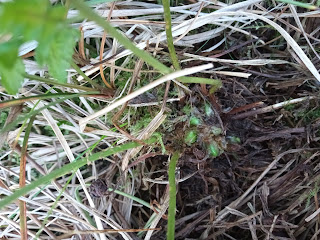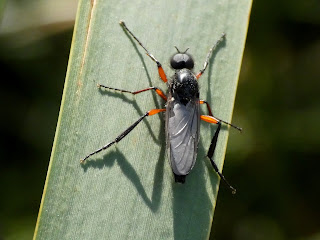Wednesday, 8th Sptember 2021. Wessenden Moor / Featherbed Moss
Leader : Kay McDowell
We met on a warm, sunny day approx 26
degrees C with a light breeze, “not unlike Tenerife” exclaimed Mike. The
weather was unusual as the car park is approximately 490 feet (150m) above sea
level and quite often shrouded in mist and drizzle. Our aim was to concentrate
on the recovering moors after drain blocking and cessation of grazing, in
particular to look at ferns and willow scrub. This involved walking along the
old Pennine Way and wandering off the path to look at interesting plants and
potentially interesting areas.
We didn’t have to walk far as just near the car park were six fir clubmoss (Hupherzia selago) growing in a peaty bare patch with some bog asphodel (Narthecium ossifragum) growing nearby. The bog asphodel is a new record for tetrad SE 0506.
We examined the pale scales of narrow
buckler-fern (Dryopteris carthusiana) and compared them with broad
buckler-fern (Dryopteris dilitata) nearby. Mike showed us a feature of
narrow buckler-fern, if you uncover the crown with your fingers digging down it
is green in colour unlike broad buckler-fern which is brown.
We also recorded golden-scaled male-fern (Dryopteris
affinis ssp. borreri) and looked at the ‘chanterelling’ indusia.
A small stand of grass caught our attention which appeared to be Calamagrostis, but unsure as to which one we decided to identify them using the key in ‘Hubbard’. The leaf-blade was hairy on its upper side which indicated it was purple small-reed (Calamagrostis canescens), unlike wood small-reed (Calamagrostis epigejos) which has hairless leaf-blades. The purple small-reed is a new record for this 10km square.
In a sheltered dip we came across polypody (Polypody vulgare) and Mike showed us the annulus with a X 20 lens, seeing the orange stripes was amazing as I’d only seen these using a microscope on The Fern Guide course with Chris and Hazel Metherell in 2019.
About five metres from the path we saw several royal fern (Osmunda regalis), including a mature plant approximately 75cm to 1m in height producing spores which was unexpected due to the height above sea level.
Mike and I saw a strange D. borreri with congested pinnules and a bald stripe either side of the scales on the stipe which may be D. lacunosa, also known as Alpine Male-fern, which according to James Merryweather is “more frequent in higher rainfall areas of the west”. Further investigation is needed next year.
Everyone agreed it had been a lovely day. We had met up with a couple of Saddleworth Naturalists members after not seeing them for a couple years due to the pandemic.
Additional
comments from Ken Gartside : I noted a couple of interesting larvae up there......
Broom Moth - Ceramica pisi
cat/larva as spotted by Margaret and the wonderfully named True Lover's
Knot - Lycophotia porphyrea caterpillar...
Not to mention the Bibio pomonae – this is another
Heathland/moors specialist whilst we were up there, they were tootling about
with dangly legs, same genus as St Marks fly.








